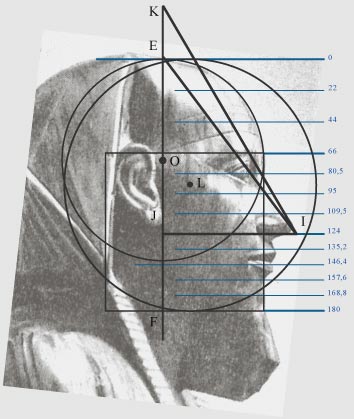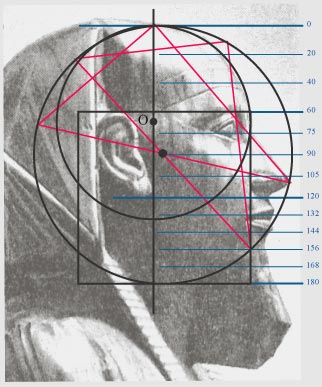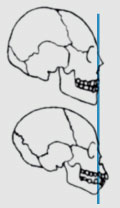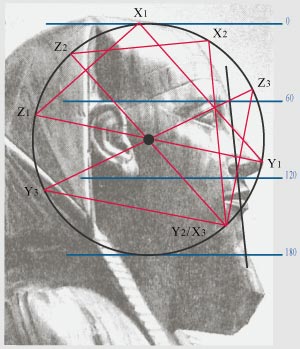-
From a history of ancient Egypt it was not kept any written data on geometry,
namely there are no books or texts in which geometrical knowledge are written,
but there were architectural constructions of pyramids and temples, and also
there were images in which knowledge on geometry of ancient Egypt are displayed.
Attentive research of Egyptian images allows to understand geometry and
including allows to understand geometrical proportions of a human face and body
that is
necessary for understanding of a human essence from the point of view of physiognomy.
For example, the sculptural image of facial profile of the pharaoh Chephren.


Two charts show the sculptural image of the pharaoh Chephren, but charts
differ as are compared to the physiognomic scale of measurements differently. In
the left chart the image of the pharaoh Chephren is correlated to verticals of
the square of feelings, namely the side of the square is correlated to the most
expressed points of eyebrows and chin, and consequently the image has inclined
position. In the right chart
the image of the pharaoh Chephren has position which is fixed in the sculpture,
and consequently verticals of the square of feelings correspond with the
expressed point of eyebrows but do not correspond with the expressed point of a
chin. It is the common feature of sculptures and other images
in which the physiognomic sphere of feelings is inclined from a vertical.
It is possible to assume that sculptors of ancient Egypt have inclined
physiognomic sphere of feelings from a vertical to bring to a focus to relevancy
of feelings.
Or it is possible to assume that notion about proportions of a human face in
ancient Egypt corresponded to type of a skull and has been caused by racial
features of people, if to consider concepts of modern anthropology in which
anthropologists distinguish the European and African types of skulls, that is
shown on the following chart.
This chart shows exaggerated images in which distinctions of European and
African types are exaggerated.
Actually among Europeans and Africans it is possible to see skulls of both
types. The African type of a skull is more often characteristic of female facial
appearance and the European type of a skull is characteristic of male facial appearance.
 |
The African type of a skull below has more expressed
lips in comparison with the European type above, if to apply to the
analysis of images the physiognomic scale of measurements which are
offered on pages of this site, and consequently the Egyptian sculptors
have made the sculptural image of pharaoh Chephren with the inclination
of sensual sphere from a vertical that the sculpture correspond with the
African type. Or the Egyptian sculptors have not considered correct vertical position of the represented face, and consequently in the sculpture of pharaoh Chephren have fixed position according to which verticals of the square of feelings are deflected and do not correspond with the expressed point of a chin. |
-
Anyhow, but by comparison of a face to the physiognomic scale of measurements
in the images of pharaoh Chephren it is possible to see geometrical laws which
are caused by proportional ratios of physiognomic spheres and proportions of the
sacred Egyptian triangle which in both cases determines proportions of the shown
sculpture.
In the right chart the distance from top of a head up to the top edge of an ear
has size of 60 zens and the distance from the bottom edge of an ear up to a chin
has size of 60 zens. And also the size of an ear is 60 zens, namely the ear
position coincides with correct parameters of physiognomic spheres that is
criterion of correct proportions of a human face in a context of physiognomy.
In the left chart the image of pharaoh Chephren is correlated with the correct
vertical of the physiognomic scale of measurements, and as a result sizes of
spherea are following: consciousness has 66 zens, individuality has 56 zens,
sensuality has 58 zens, and thus position of the ear does not coincide with
borders of physiognomic spheres.
But in the left chart the geometrical figuree JEI has ratio of sides 3:4:5 that
is the sacred Egyptian triangle. Namely if to draw the line from point I (tip of
a nose) to point E (contact of the circle of consciousness with the line of top
of a head) then triangle JEI is sacred Egyptian, though physiognomic spheres
have wrong proportional ratios. And in the right chart the sacred Egyptian
triangles (red color) have wrong configurations though coincide with the top of
a head and the tip of a nose.
It testifies to not casual proportions which are fixed in the sculpture of
pharaoh Chephren, and also allows to assume that the sculptural image and the
pyramid of Chephren are constructed according to the uniform geometrical
principle which is included in proportions of the sacred Egyptian triangle. In
particular the angle of inclination of lateral sides of the Chephren's pyramid approximately
is 53 degrees, and also the angle of triangle JEI in point I
approximately is 53 degrees in the sculptural image of pharaoh Chephren. And
also there are some other surprising geometrical concurrences according to which
it is possible to assume that the shown sculpture has been calculated according
to geometrical principles which correspond with geometry of the Chephren's
pyramid and which are included in the sacred Egyptian triangle.
Probably, in ancient Egypt there was a special method for calculations of
proportions in a human face. Namely sculptors of ancient Egypt drew the circle
which was tangent to the tip of a nose and top of a head, then ancient sculptors
entered the sacred triangle with ratio of sides 3:4:5 in the circle, and then
Egyptians calculated necessary proportions of a human face as a result of
rotation of the sacred triangle in the circle, that is shown on the following
chart.
 |
Red triangles X1Y1Z1
- X2Y2Z2
- X3Y3Z3
correspond to sacred Egyptian or Pythagorean proportions. Three triangles are identical and constructed as a result of
rotation within the framework of the circle which is tangent to the
nose-tip and top of a head. Lines X1Y1 - X2Y2 - Y3Z3 determine position of the eye. Line X2Y2 determines edges of lips, and also pay attention that line X2Y2 is parallel to the line which is tangent to the expressed points of chin and eyebrows. Except for the shown lines as a result of rotation of the sacred Egyptian triangle in the circle it is possible to find many other physiognomic parameters, namely for calculation of required proportions of a human face it is possible to make more complex drawing. And also it is possible to compare the face of this or that person to geometrical lines of the shown sacred triangles, then it is possible to do conclusions about proportional harmony or disharmony of facial features. |
In essence the shown chart is a method of calculations which could applied in
ancient Egypt to calculations of proportions of a human face, but which differs
from the method of calculations by means of the physiognomic scale of
measurements which are offered on pages of this web site. Two methods in view of
physiognomy yield identical results, but the method of calculations by means of
the physiognomic scale is convenient for psychological characteristics which can
be carried out according to the calculated proportional ratios and according to
geometrical figures which designate physiognomic spheres and levels of a human
face. And the ancient Egyptian method is interesting from the point of view of
esoteric senses which are included in geometrical proportions of the sacred
Egyptian triangle, as the system of geometry of ancient Egypt is original
display of sacral geometry of the universe. And accordingly the sight at
proportions of a human face from the point of view of ancient Egyptian geometry
is interesting to understanding of geometrical laws which explain principles of
sacral beauty and harmony.
The shown ancient Egyptian method for calculations of proportions of a human
face by means of sacred triangles is a hypothesis, as actually sculptors and
architects of ancient Egypt could used any other methods of calculations, but
anyhow imposing of sacred triangles on profile of a human face, and in
particular on the sculptural image of pharaoh Chephren specifies possible
existence of this method.
The following page gives the description of harmonious proportions in lines of geometrical figures according to which in a context of physiognomy it is possible to calculate harmony and beauty in faces of people.
-